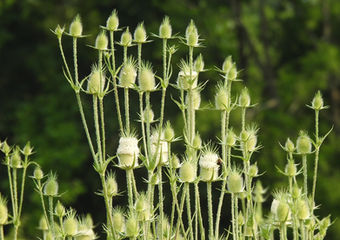Cut Leaf Teasel
Common Name: Cut Leaf Teasel.
Scientific Name: Dipsacus Laciniatus.
What to look for? Cone-shaped clusters of small, white flowers sitting high atop a tall stem. The Cut Leaf Teasel is an invasive weed but is visually interesting. During the first year, this plant consists only of a low rosette of long, basal leaves. It is during the second year that the Cut Leaf Teasel develops stems. Each stem terminates into a long, cylindrical spike consisting of hundreds of tiny white flowers that typically bloom from the bottom of the spike up. When the white flowers are absent it looks similar to a thistle, with prickly bracts at the base of the flowers as well as the spike. A spike creates a seed head with hundreds of seeds that ripen to a dark brown.
Where can they be found at Carillon Stonegate Pond?Cut Leaf Teasel plants were found in the restored prairie at Stonegate Park.
How big are they? The Cut Leaf Teasel grows up to six (6) feet. The oblong leaves are approximately 12 inches long and three (3) inches across. A cylindrical spike that holds hundreds of tiny flowers is approximately one (1) inch across and several inches in length.
Where do they grow and thrive? The non-native Cut Leaf Teasel occurs across most areas of Illinois. It was introduced into North America from Eurasia. Across the U.S., this plant is found in the Northeast, Midwest, central Great Plains, Colorado, and Oregon. The Cut Leaf Teasel is found in prairies, degraded grassy meadows, savannas, woodland borders, pastures and abandoned fields, roadsides, and waste areas. It can invade high quality prairies and savannas.
When do they bloom? The blooming period occurs from mid-summer into fall. It typically lasts about 2 months for a colony of plants. The Cut Leaf Teasel is a monocarpic perennial that flowers and produces seed only once in a lifetime before dying.
Do birds, insects or other wildlife associate with this plant? The nectar of the Cut Leaf Teasel flowers attracts bumblebees and other bees, butterflies, and skippers. Animals shun the tough prickly foliage of this plant. Except for flower-visiting insects, the Cut Leaf Teasel seems to have limited ecological value to wildlife.
Interesting Facts About the Cut Leaf Teasel:
-
Dip’sacus comes from the Greek word dipsa, which means “thirst”. It refers to the fused leaf bases that collect rainwater. Lacinia’tus means torn or deeply cut.
-
The Cut Leaf Teasel is a monocarpic perennial, in that it is non-flowering plants during its first year or so until they store up enough energy to produce a flowering shoot.
-
Cut Leaf Teasel was brought into the US as early as the 1700’s by the European colonists.
-
Cut Leaf Teasel is an introduced species that can invade high quality prairies and savannas.
-
With its spiny-looking floral spikes and prickly stems, Teasel has a distinctive appearance that resembles no native plant in Illinois.
For more information on the Cut Leaf Teasel and sources of information used in this blog (these are several of the sources that I am using to learn as I blog), please visit Illinois Wildflowers, Minnesota Wildflowers, U.S. National Park Service, and Purdue University Weed Science.
The Carillon at Stonegate community is very fortunate to have a variety of wetland, forest and prairie environments conducive to a variety of birds and other wildlife, insects and plants. Our community and the Kane County Forest Preserve do an exceptional job in maintaining this natural environment – both for the benefit of the birds and wildlife and for our residents to enjoy.
Take a hike and see what you can find – and identify!












